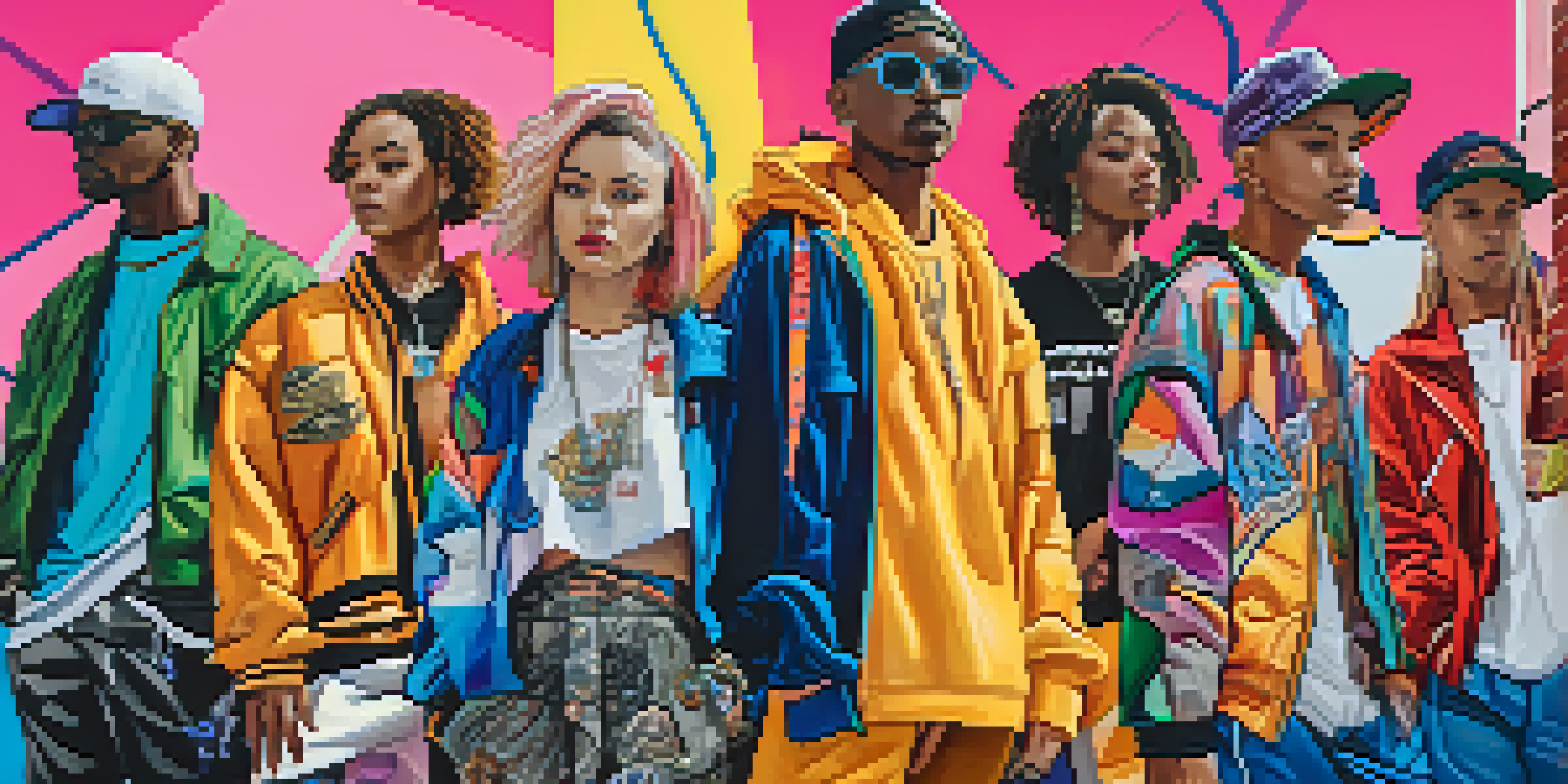Breaking Stereotypes: Gender Fluidity in Streetwear Culture

Understanding Gender Fluidity in Fashion
Gender fluidity refers to a flexible range of gender identities that can change over time. In streetwear culture, this concept challenges traditional notions of masculinity and femininity, allowing individuals to express themselves beyond binary labels. By embracing gender fluidity, fashion becomes a canvas for personal expression, reflecting the diversity of human experiences.
Fashion is the armor to survive the reality of everyday life.
Streetwear, often rooted in urban and youth culture, has long been a space for rebellion against mainstream fashion norms. The rise of gender fluidity within this sphere has empowered designers and consumers alike to break away from restrictive gender roles. As a result, we see a growing number of brands creating unisex collections that cater to all identities.
This shift not only influences what we wear but also affects how we perceive ourselves and others. When clothing is no longer confined to gendered expectations, it opens the door for authentic self-expression. This transformation is crucial in fostering a more inclusive environment in fashion and beyond.
The Role of Influencers in Promoting Fluidity
Influencers play a vital role in shaping trends and attitudes in streetwear culture. Many prominent figures in this space openly identify as gender fluid, using their platforms to challenge stereotypes and promote inclusivity. By showcasing their unique styles, they inspire others to explore their own identity through fashion.

For instance, influencers like Jaden Smith and Amandla Stenberg have made headlines for their gender-fluid fashion choices, sending a powerful message that style knows no gender. Their bold looks encourage fans to embrace creativity and authenticity, rather than conforming to societal expectations. This visibility is crucial in normalizing gender fluidity within streetwear.
Embracing Gender Fluidity in Fashion
Gender fluidity allows for personal expression beyond traditional gender norms, fostering inclusivity in fashion.
As followers adopt these trends, they not only emulate the looks but also engage in conversations about gender identity. This ripple effect helps to break down stigmas and foster acceptance, ultimately contributing to a more diverse and vibrant fashion landscape.
Streetwear Brands Embracing Gender Fluidity
Several streetwear brands have taken significant steps toward embracing gender fluidity in their designs. Labels like Off-White and Yeezy have introduced unisex collections that appeal to a broader audience, allowing everyone to find their place in the fashion world. These brands recognize that fashion should not be limited by gender but rather celebrate individuality.
Style is a way to say who you are without having to speak.
In addition to established names, emerging designers are also making waves with their gender-fluid collections. Brands such as 69 and Telfar are redefining streetwear standards by creating pieces that can be worn by anyone, regardless of gender identity. This shift reflects a growing understanding that fashion is about personal expression and comfort.
By championing gender fluidity, these brands not only diversify their offerings but also attract a more inclusive customer base. This approach not only enhances brand loyalty but also promotes a sense of community among consumers who feel represented in the fashion narrative.
The Impact of Gender Fluidity on Consumer Choices
As gender fluidity gains traction, consumer preferences in streetwear are evolving. Shoppers are increasingly seeking brands that align with their values, favoring those that promote inclusivity and diversity. This shift in demand encourages brands to rethink their marketing strategies and design processes to cater to this new wave of consumers.
Moreover, the desire for gender-neutral clothing reflects a broader cultural change. Today's consumers are less interested in adhering to traditional gender norms and more focused on finding pieces that resonate with their personal style. This growing preference for versatility means that streetwear brands must innovate to stay relevant in a competitive market.
Influencers Drive Change in Style
Prominent influencers challenge stereotypes and inspire others to explore their identity through gender-fluid fashion.
Ultimately, this shift benefits everyone—consumers enjoy the freedom of choice, while brands expand their reach and foster inclusivity. By prioritizing gender fluidity, the streetwear industry is not only revolutionizing fashion but also contributing to a more accepting society.
Challenges Faced by Gender Fluid Individuals in Fashion
Despite the progress towards inclusivity, gender fluid individuals still encounter challenges in the fashion world. Many face difficulties finding clothing that fits their identity, as mainstream brands often stick to traditional gendered sizing and styles. This lack of representation can lead to feelings of exclusion and frustration among those seeking to express their true selves.
Moreover, societal perceptions and biases can create obstacles for individuals who wish to embrace gender fluidity in their fashion choices. They may face judgment or discrimination, both online and offline, which can deter them from fully expressing their identity. This highlights the importance of fostering acceptance and understanding within the fashion community.
Addressing these challenges requires a concerted effort from designers, brands, and consumers alike. By advocating for greater representation and inclusivity, we can create a fashion landscape that welcomes and celebrates diversity in all its forms.
The Future of Gender Fluidity in Streetwear
Looking ahead, the future of gender fluidity in streetwear appears promising. As conversations around identity continue to evolve, we can expect to see even more brands adopting inclusive practices and creating collections that resonate with diverse audiences. This trend represents not only a shift in fashion but also a broader cultural transformation.
As consumers become increasingly vocal about their preferences, brands will be compelled to listen and adapt. The demand for gender-neutral clothing and diverse representation will likely shape the future of streetwear, pushing designers to innovate and expand their offerings. This evolution will ultimately benefit everyone, fostering a more inclusive environment.
Brands Adapt to New Consumer Trends
Streetwear brands are increasingly offering unisex collections to meet the evolving preferences of consumers seeking inclusivity.
Ultimately, the embrace of gender fluidity in streetwear serves as a powerful reminder of the importance of self-expression and acceptance. By breaking down barriers and challenging stereotypes, we can create a fashion landscape where everyone feels seen, valued, and empowered to express their true identity.
Celebrating Diversity in Streetwear Culture
Celebrating diversity is at the heart of the streetwear movement. As gender fluidity becomes more mainstream, it paves the way for a richer tapestry of styles and identities within the fashion landscape. This celebration not only enhances creativity but also fosters a sense of belonging among individuals who have historically felt marginalized.
Events such as fashion shows and community gatherings dedicated to gender fluidity play a crucial role in promoting inclusivity. These platforms allow individuals to showcase their unique styles while connecting with others who share similar experiences. By creating safe spaces for expression, we foster a community that values authenticity and diversity.

As we continue to celebrate diversity in streetwear, it’s essential to remember the power of fashion as a form of self-expression. By embracing all identities, we can contribute to a more inclusive world where everyone feels empowered to express themselves freely and confidently.